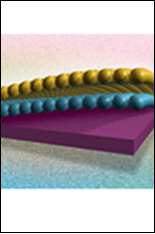NEES News
Atomic Layer Deposition: Precise Control Smaller than the Eye Can See
This article is reprinted with permission from "Frontiers in Energy Research", 2015 Spring edition, a newsletter of the Department of Energy.
From the touchscreen on your smartphone to antireflection coatings on eyeglasses, a very thin film can make a huge difference. Whether it's allowing the device to sense your finger or preventing corrosion, films and coatings can drastically change a material just by covering the surface with a small amount of a new material. The technique of atomic layer deposition (ALD) allows companies and researchers to precisely control thin films using a minimal amount of material, lowering total product cost, and determine the effect of film thickness on novel devices. The ALD process is aptly named because it gives you an idea of how the process works. The technique involves building a material one atomic layer at a time, relying on chemical reactions at the surface to be self-limiting so that only one atom is attached to the surface before the next layer is put down. In general, there are two starting molecules that react to form the final film. 1. One starting chemical—we'll call it molecule A—is introduced as a gas to attach to the surface of a substrate (on whatever the film is grown). After A has completely covered the surface, additional A molecules cannot react further, and any excess of molecule A is pulled out by vacuum. 2. Molecule B is introduced and reacts with molecule A on the substrate to give the first AB layer. Molecule B is only able to attach to the surface where A is exposed. 3. In this self-limiting reaction, once B covers all of A, molecule B will stop attaching to the substrate. 4. Excess B is cleared from the chamber, completing one cycle of ALD and resulting in a film that is less than a nanometer thick. Repeating ALD cycles result in thicker and thicker films, but with precise control and uniform coverage of the surface. Because the precursor molecules are gaseous, ALD covers flat surfaces as well as rough or porous materials. The latter materials are useful for processes such as charge storage and catalysis where large surface areas are beneficial. ALD has been used for many purposes, and several Energy Frontier Research Centers (EFRCs) have been using the technique for everything from lithium-ion batteries to biomass catalysts. For example, the Center for Solar Fuels (UNC) has used ALD to improve dye-sensitized solar cells. Titanium dioxide coatings deposited by ALD onto nanoparticles of semiconductors before the dye is attached prevent electrons from traveling the wrong way in the device. This layer improved many aspects of the solar cell, resulting in higher efficiency photovoltaic devices. The key was to make the titanium dioxide layer thick enough to be effective, but thin enough that the device could still work properly. The precision of ALD allowed researchers to tune the film to an ideal thickness of just 2.4 nanometers, more than 40,000 times thinner than a piece of paper. At the [University of Maryland-led] Center for Nanostructures for Electrical Energy Storage (NEES), ALD is central to their work on energy storage and has been used for everything from protective coatings to entire batteries. Recently, they have used ALD to produce an electrode with a high power density for lithium-ion batteries by coating ruthenium dioxide on carbon nanotubes, combining a material that stores lithium ions efficiently with a nanostructured material that gives the electrode a very high surface area. Also, NEES researchers have used ALD to fabricate tiny batteries inside of nanopores; these batteries are so small that a billion of them form an array smaller than a postage stamp. Scientists at the Center for Electrical Energy Storage (CEES) have also made progress on lithium-ion battery technology by developing an ALD process for a useful material. Gallium sulfide is a wide-band-gap semiconductor that has applications in optoelectronic and photovoltaic devices, which researchers have now built using ALD. Their films show very high cyclability (number of times you can recharge a battery) and capacitance (how much power a material can store) when used as a lithium-ion electrode. Researchers at the Institute for Atom-Efficient Chemical Transformations (IACT), a former EFRC, have used ALD to increase the selectivity of catalyst nanoparticles used to produce fuel from biomass. Previous research showed different facets of nanoparticles serve as active sites for different reactions. Using ALD to cover certain facets and defects, they increased the selectivity of the catalyst. This means the preferred reaction was favored, and there were not as many side reactions and unfavorable by-products when converting biomass to transportation fuels. The reader is encouraged to peruse their new review article on catalyst design and ALD. Finally, a new EFRC, the Inorganometallic Catalysis Design Center (ICDC) will use ALD to form energy-relevant catalytic materials. Look for papers from the ICDC in the future to keep up with new ALD developments. ALD is a promising technique that allows precise control over a wide range of materials. As devices get smaller and smaller, atomic control becomes increasingly important for pushing forward new technologies. --end-- About the author: Ashley Marshall is a graduate student in the Center for Advanced Solar Photophysics (CASP), working at the National Renewable Energy Laboratory through the University of Colorado, Boulder. Her research focuses on using quantum dots in solar cells to utilize unique photophysics, which will allow us to overcome the theoretical efficiency limits in solar cells. Acknowledgments: Liu, et al. & Gregorczyk, et al.: This work was supported by Nanostructures for Electrical Energy Storage (NEES), an Energy Frontier Research Center funded by the DOE, Office of Science, Office of Basic Energy Sciences. 1The authors acknowledge support from the Maryland NanoCenter and the NispLab. 2K.G. is partially supported by the L-3 Communications fellowship. More Information: Alibabaei L, BH Farnum, B Kalanyan, MK Brennaman, MD Losego, GN Parsons, and TJ Meyer. 2014. "Atomic Layer Deposition of TiO2 on Mesoporous nanoITO: Conductive Core−Shell Photoanodes for Dye-Sensitized Solar Cells." Nano Letters 14(6):3255-3261. DOI: 10.1021/nl5006433 Liu C, EI Gillette, X Chen, AJ Pearse, AC Kozen, MA Schroeder, KE Gregorczyk, SB Lee, and GW Rubloff. 2014. "An All-in-One Nanopore Battery Array." Nature Nanotechnology 9:1031-1039. DOI:10.1038/NNANO.2014.247 Gregorczyk KE, AC Kozen, X Chen, MA Schroeder, M Noked, A Cao, L Hu, and GW Rubloff. 2015. "Fabrication of 3D Core-Shell Multiwalled Carbon Nanotube@RuO2 Lithium-Ion Battery Electrodes through a RuO2 Atomic Layer Deposition Process." ACS Nano 9(1):464-473. DOI:10.1021/nn505644q Meng X, JA Libera, TT Fister, H Zhou, JK Hedlund, P Fenter, and JW Elam. 2014. "Atomic Layer Deposition of Gallium Sulfide Films Using Hexakis(dimethylamido)digallium and Hydrogen Sulfide."Chemistry of Materials 26(2):1029-1039. DOI: 10.1021/cm4031057 O'Neill BJ, DHK Jackson, J Lee, C Canlas, PC Stair, CL Marshall, JW Elam, TF Juech, JA Dumesic, and GW Huber. 2015. "Catalyst Design with Atomic Layer Deposition." ACS Catalysis 5:1804-1825. DOI: 10.1021/cs501862h Zhang H, XK Gu, C Canlas, AJ Kropf, P Aich, JP Greeley, JW Elam, RJ Meyers, JA Dumesic, PC Stair, and CL Marshall. 2014. "Atomic Layer Deposition Overcoating: Tuning Catalyst Selectivity for Biomass Conversion." Angewandte Chemie International Edition 53:12132-12136. DOI:10.1002/anie.201407236
March 12, 2015 Prev Next |












